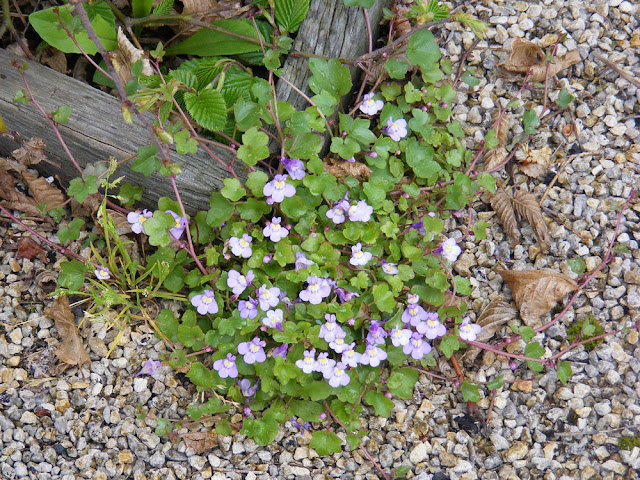On 1 April the
Association de botanique et de mycologie de Sainte Maure de Touraine had an outing to the small town of Saint Epain. The aim was to survey the plants growing in the streets so mostly we were looking at 'weeds'. Here is a selection:
 |
| Common Fumitory. |
There was a lovely patch of Common Fumitory Fumaria officinalis (Fr. Fumeterre officinale) along a lane. Fumitories are notoriously difficult to identify to species level so there was a lengthy discussion about what it was and how one separated the species. The 'officinale' part of its name tells you that it must once have been a medicinal plant. In fact it is now known to contain alkaloids that could be dangerous, but it was once used for eye and skin conditions. The 'fumitory' part of the name refers to the idea that the flowers look like wisps of smoke rising from the earth. You wouldn't guess it to look at it, but the fumitories are related to poppies.
 |
| Even the experts have to consult the book when identifying fumitories. |
 |
| Ivy-leaved Toadflax. |
Ivy-leaved Toadflax Cymbalaria muralis (Fr. Cymbalaire des murs) is a common presence on walls and pavements. It's pretty enough that most people don't consider it a weed. In fact it is not really native to the Touraine, but naturalised here after being introduced from the Mediterranean (probably a thousand years ago). It has the peculiar habit of sending new shoots out into the light, but when it has seeds, the new shoots head for crevices where the seeds will be deposited to germinate.
 |
| Saxifraga tridactylites. |
We found tiny little Rue-leaved Saxifrage Saxifraga tridactylites (Fr. Saxifrage à trois doigts) growing on the exterior of the church.
 |
| Looking at pavement plants. |
 |
| Purple Toothwort. |
The star plant for the day was
Purple Toothwort Lathraea clandestina (Fr.
Lathrée clandestine). Along the banks of the little Manse River that flows through town is the largest colony in Indre et Loire of this rare parasitic plant. It is one of those many plants that are locally common here but rare over much of their range, and in decline. We stopped to exchange a few words with some locals whose garden backed on to the river. There was a small group of men enjoying a roast chicken lunch and obviously quite a few beers. To my considerable surprise they were interested in what we were doing and in the toothwort on their doorstep. After teasing Jean about his resemblance to Father Christmas (see photo above) they then volunteered that they had also seen
Snakeshead Fritillaries along the river bank. They were anglers, so quite familiar with the riverside vegetation, including knowing that the frits are a protected species.
 |
| Wild lettuces. |
Everywhere in the village were wild lettuces. These two plants above show the two species which are the ancestors of our cultivated lettuces, both batavia and escarole types. The wild plants are bitter, prickly and full of latex-y sap that burns the throat. Obviously gardeners over the centuries have worked quite hard on lettuce to select something edible.








3 comments:
Lovely post and photos, Susan. I'm a big fan of toadflax. It once appeared on the patio of a house I owned in California, and I took special care to encourage its spreading. Transplanted to hanging baskets, it thrived. Perhaps because my uncle's house in England was named Kenilworth, I always thought of it as the ivy with that name.
Funny photo of everyone clustered about and peering at the pavement.
The toadflax has many names -- ivy-leaved toadflax, Kenilworth ivy, coliseum ivy, Oxford ivy, mother of thousands, pennywort, wandering sailor...
I think Simon would disagree with your comment about the development of lettuce into something edible.....
Post a Comment